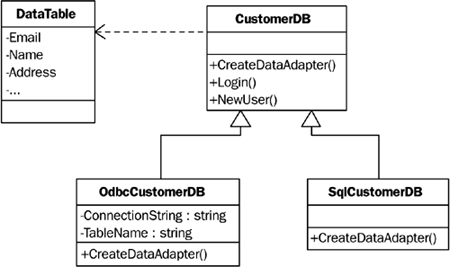Database Access with ADO.NET
ADO.NET is an interface library that provides access to various kinds of data providers, such as SQL, OLE DB, and ODBC. Although each data provider has its own set of classes, they are conceptually the same. The main classes are as follows:
- Connection: Used to establish a connection to a database; this connection is necessary to execute a command or read data. To connect to an SQL database, you use the SqlConnection class; an OdbcConnection class is used to connect to an ODBC data provider.
- Command: Executes a database command such as SELECT, INSERT, or UPDATE. Requires a database connection.
- DataReader: Exposes the data resulting from the execution of a SELECT command.
Although the classes that establish a database connection and execute commands are specific to the type of the data source, the database commands themselves are all based on SQL and are mostly compatible between the various kinds of data sources. The commands needed for this project are SELECT, INSERT, and UPDATE.
To promote cost efficiency, we store the customer information in a Microsoft Excel sheet, which is specified in the application's configuration file. The ODBC service has an Excel driver that can be used to store the customer records in an XLS file. However, we will encapsulate all database dependencies in an additional layer to allow the replacement of the data provider later based on growth of the business.
Figure 12.3 shows the class diagram for the data access layer. DataTable is a simple .NET Framework class for caching the content of a database table, in our case the customer table. CustomerDB is an abstract class providing higher-level API functions specific to the kind of operations performed by Online Photo Shopnamely, validating login credentials and creating a new user account. CustomerDB also defines an abstract method to create a new DbDataAdapter instance. This method must be implemented by inherited classes because it is specific to the data source type. For now, SqlCustomerDB will not be implemented. It is shown only to visualize how this possible future change can be addressed.
Figure 12.3. Class Diagram for Database Access Utilities

Introducing .NET
- Introducing .NET
- The Need for .NET
- The .NET Framework
- The C# Language
- Debugging and the IDE
- References for Further Reading
Introducing Software Engineering
- Introducing Software Engineering
- Introducing Software Engineering Practices
- Choosing a Software Development Model
- Commonly Used Software Development Models
- Conclusion
- References for Further Reading
A .NET Prototype
- Getting Started
- Evaluating .NET for Windows Client Applications
- Our First .NET Application
- Prototyping
- Implementing the SmartNotes Application
- Visual Studio.NET: Platform of Choice
- References for Further Reading
Project Planning
- Project Planning
- The Project Vision and Business Case
- The Initial Use Case Model
- Project Requirements
- Initial Project Planning
- Initial Risk Analysis
- Initial Requirements Analysis and Design
- Conclusion
- References for Further Reading
The Photo Editor Application
- The Photo Editor Application
- The Refined Project Vision and Business Case
- Refined Requirements for Online Photo Shop
- Analysis of the Photo Editor Requirements
- Design of the Photo Editor Application
- The Detailed Project Schedule
- Implementation of the Photo Editor Application
- Unit Tests
- Conclusion
- References for Further Reading
GDI+ Graphics Extensions
- GDI+ Graphics Extensions
- Requirements for the GDI+ Extensions
- Analysis of the GDI+ Extensions Requirements
- Design of the GDI+ Extensions
- Project Management Issues
- GDI+ Programming
- Drawing GDI+ Primitives
- Unit Tests
- Conclusion
- References for Further Reading
Advanced GDI+ Operations
- Advanced GDI+ Operations
- Advanced GDI+ Extensions
- Analysis of the Advanced GDI+ Extensions Requirements
- Design of the Advanced GDI+ Extensions
- Project Management Issues
- Using Pens and Brushes in GDI+
- Implementation of Regions, Pens, and Brushes
- Unit Tests
- Conclusion
Dynamic Loading of Components
- Dynamic Loading of Components
- Requirements for Image Postprocessing Components
- Analysis of the Image Postprocessing Requirements
- Design of the Image-Processing Components Using Late Binding
- Project Management Issues
- Implementing Dynamically Loadable Image Postprocessing Plugins
- Unit Tests
- Conclusion
- References for Further Reading
Accessing System Resources
- Accessing System Resources
- Refining Requirements for 3D Text Display
- Three-Dimensional Rendering Technologies
- Analyzing User Interface Needs
- Using OpenGL.NET
- Adding 3D Text to the Photo Editor Application
- Conclusion: Dont Reinvent the Wheel
- References for Further Reading
Performance Optimization, Multithreading, and Profiling
- Performance Optimization, Multithreading, and Profiling
- Requirements for Performance Optimization
- Analysis of the Editor Optimization Requirement
- Design of the Optimizations
- Project Management Issues
- Multithreading and Optimization Implementation
- Unit Tests
- Conclusion
- References for Further Reading
Building the Web Application with ASP.NET
- Building the Web Application with ASP.NET
- Online Store Requirements
- Analyzing Interfaces and Activities
- Breakdown of the Code Modules
- Implementation of Online Photo Shop
- Conclusion
Security and Database Access
- Security and Database Access
- Secure Checkout
- Integrating Externally Supplied Software
- E-mail, Password, Credit Card: Creating a Customer Profile
- Secure Web Applications
- Database Access with ADO.NET
- Putting It All Together
- No Longer under Construction
- References for Further Reading
Product Release
EAN: 2147483647
Pages: 123
